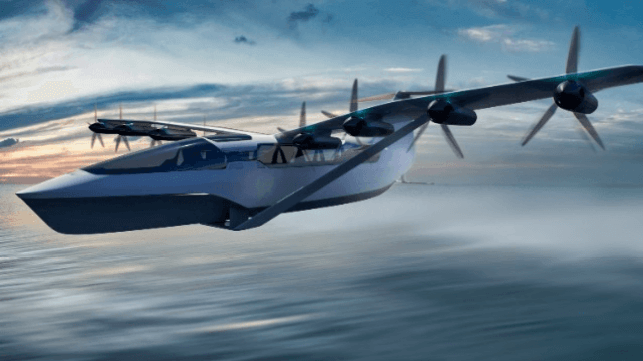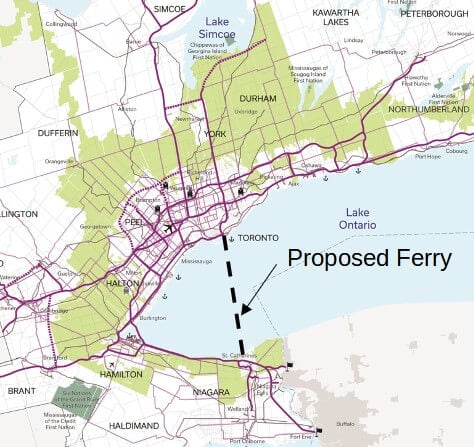Ongoing Plans for a Fast Ferry Service Across Lake Ontario

The direct distance across water between Toronto, Canada and the St. Catharines – Niagara region is about half the overland distance by road or rail. As a result, there have been ongoing discussions about fast ferry service across the western region of Lake Ontario.
Introduction
The successful fast Lake Express ferry between Muskegon MI and Milwaukee WI is a direct route across Lake Michigan that is shorter than overland road or rail distance, bypassing traffic congestion on highways in Chicago. Its success prompted public sector investment into developing a fast ferry across Lake Ontario between Toronto, Ontario and Rochester NY. The inability of that service to generate sufficient revenue to cover operating costs resulted in its closure. There have been several earlier attempts at developing fast ferry service across the western region of Lake Ontario, between Toronto and St. Catharines.
Several earlier ferry boat services between Toronto and Niagara – St. Catharines region attracted summertime tourist traffic, despite having been in direct competition with passenger train and express intercity bus service that offered competitive travel duration at competitive travel prices, with greater departure frequency. Boat technology of the 1950s and 1960s could not offer the high speed of service required to compete with overland transport on this route, while short-haul airplane travel was prohibitively expensive. Recent developments in maritime technology offer the promise of fast ferry service across western Lake Ontario.

Courtesy Ontario Ministry of Transportation
Promising Early Technology
During the 1950s and 1960s, British inventor named Cockerill developed vehicles dubbed “hover-craft” that could float on a cushion of air while traveling above water, with ability to stop on land at a beach. Successful prototype testing resulted in the development of commercial hovercraft that carried passengers and freight across the English Channel between Dover, England and Calais, France as well as between mainland England and several offshore islands. Powered by turbine engines, the large hovercraft consumed substantial volumes of fuel. Outside of England, there was little interest in developing high-speed hovercraft commercial ferry services.
During late 1960s into 1970s, engineers at Boeing Aircraft Company adapted small-scale versions of airplane wing technology to operate under water, resulting in the development of high-speed hydrofoil boats that were introduced into fast ferry services at locations such as Hong Kong. Following the precedent from Boeing, many other companies have developed a variety of hydrofoil vehicles that includes hydrofoil surfboards and hydrofoil kayaks that are both capable of traveling smoothly above choppy water, at elevated speed. Large-scale versions of both hovercraft and hydrofoil craft have been considered for service between Toronto and St. Catharines.
Convergence of Technologies
The treatise entitled Competing for the Future by onetime University of Michigan professor of business Dr. C. K. Prahalad focuses on combining evolving technologies to develop competitive new products and services. Advanced development in battery technology can allow small commuter planes to fly between Toronto and Niagara – St. Catharines airport at a lower cost than gasoline-powered planes. Catamaran hydrofoil ferry boats that carry 30 passengers can be powered by outboard-mounted vertical-crankshaft V-12 engines of 600 horsepower that drive twin counter-rotating propellers, with loop-shaped propeller blades on boats offering greater efficiency when sailing at elevated speed.
Related developments in kite technology can fly an airborne kite-sail in powerful wind at high elevation above water, while pulling a boat at speed. Developments in ground effect wing technology allows winged boats to travel at very high speed with boat hull above the water surface. There is potential for high-speed ground effect planes, battery-electric planes, wind-powered vessels pulled by kite-sails and high-speed hydrofoil boats along with a multitude of hybrid variants of these technologies to travel at elevated speed between St. Catharines and Toronto., including close to and above the water surface.
Electric Propulsion
Ontario experiences an annual summer-time shortage of electric power generation, limiting summer time operation of electric vehicles such as battery-electric ferry services or battery-electric short-haul airplane services across western Lake Ontario. During winter, Ontario generates excess electric power that is sold at bargain basement prices during the overnight hours. During such time, it would be possible to recharge battery-electric transportation vehicles such as the Regent Craft ground effect plane. Between mid-June and mid-September, fast ferry technology powered by combustible liquid or compressed gaseous fuel or even wind could provide service between St. Catharines and Toronto.
Cavitation
Discussions about high-speed marine vessels needs to include mention of cavitation that occurs when propellers rotate at very high speed or when hydrofoils travel through water at very high speed. Cavitation results in water ‘boiling’ at low temperature, potentially damaging propellers that lose efficiency and propulsive thrust, also damaging hydrofoils that lose ‘lift’ and stall like an airplane wing, losing the ability to carry the vessel above water. When cavitation restricts the sailing speed of propeller driven hydrofoil vessels, ground effect technology is able to achieve greater speed while using aeronautical propulsion.
Ground Effect Transport
Companies in the United States, Germany and Singapore offer wing-in-ground effect planes that travel at high speed, close to the water surface while consuming one third to one half of the energy required by an airplane. While these vehicles currently carry 8 to 12 passengers plus a pilot, Widget Works of Singapore, Tandem Wing of Germany, and Regent Craft in the USA all plan to build larger versions of their technology. The Regent Craft ground effect plane rides on hydrofoils prior to lift off as well as after having slowed for touch down.
At speed, the underside of wings of ground effect planes rapidly circulate air to generate powerful updrafts that flow upward from the water surface, directly below the wings that keep the ground-effect vessel above water between 5% and 40% of wingspan measurement. Optional tilt-rotor propellers promise to enhance vehicle operation in and near terminals as well as when encountering waves on the lake. The battery powered Regent Craft ground effect technology is capable of achieving 180-miles per hour while competing vehicles from other builders achieving speeds of 100-miles per hour.
Hybrid Technology
Combining ground effect wing technology with hovercraft technology would allow the vehicle to lift off from and touch down on an ice-covered area of lake while being able to travel at extreme speed above a water surface. Combining hovercraft technology with retractable/extendable hydrofoils would assure smoother travel at high speed above severely choppy water along with superior energy efficiency. Designers at Regent Craft have combined hydrofoil technology, seaplane technology and ground effect wing technology in their Viceroy Sea Glider vehicle. Any of these hybrid vehicle concepts could provide fast ferry service between St. Catharines and Toronto.
A kite-sail powered vessel would combine large-scale, racing-yacht type hydrofoils with an illuminated airborne sail-kite technology flying in powerful winds at 1,000 feet above Lake Ontario. On the approach to and departure from Toronto, a kite-sail powered vessel would need to drop the kite-sail elevation to deck height so as to assure safety for airplanes that arrive at and depart from Toronto Island Airport. The addition of onboard battery-electric technology would assist with low-speed vessel propulsion in restricted port areas, while also allowing for remote control of the airborne kite-sail from the bridge.
Recreational Water Craft
A large marina at St. Catharines and multiple marinas at Toronto provide summer parking for hundreds of small recreational boats, plus a small number of yachts. Recreational boat traffic increases dramatically offshore from Toronto and St. Catharines on sunny summer weekends during July and August, also on summer weekday afternoons. There is minimal recreational boat traffic in those regions from mid-September to mid-June of the following year, when vessels such as hybrid hovercraft and hydrofoil catamaran boats would operate fast ferry services across Lake Ontario between Toronto and St. Catharines, with minimal risk of collision with small boats.
While ground-effect vessels operate at an elevation of 5% of wingspan to achieve peak energy efficiency, re-adjusting wing settings increases flight elevation above water to sufficient elevation to pass above most recreational watercraft. Operation of ground effect vessels across western Lake Ontario would require designated seaplane runways at St. Catharines and at Toronto, to allow such vessels to touch down on a water surface while avoiding possible collision with recreational watercraft. The large number of recreational water craft on Lake Ontario strengthens the case to operate some form of ground effect vessel between Toronto and St. Catharines.
Government Regulation
An absence of economic regulation and market entry control might entice entrepreneurs to lease small high-speed ferry vessels that they would operate between St. Catharines and Toronto. The service would need to offer competitive travel prices combined with competitive travel duration. Entrepreneurs would need to evaluate service viability of a 30-seat high-speed ferry vessel. While fuel prices would deter some entrepreneurs, the option of using an airborne kite-sail flying high above Lake Ontario to achieve propulsion for a hydrofoil catamaran vessel, might encourage other entrepreneurs to offer service on days when wind speed is suitable.
Conclusions
The population of the Niagara – St. Catharines region is approaching 500,000 people while that of Metro Toronto is over 2 million, with trans-lake ferry distance being half the overland distance. There are likely multiple market niches for ferry service across western Lake Ontario, including using technology with extreme high-speed capability that could attract sufficient patronage to assure viability. The technology with the greatest probability of market success would be a hybrid vehicle such as ground effect hovercraft, tilt-rotor ground effect or gyro-rotor ground effect technology capable of operating all year, dealing with both open water and lake ice conditions.
Seasonal technology capable of providing competitive trans-lake service in ice-free lake conditions would include hydrofoil – hovercraft, catamaran – hydrofoil and ground effect technology using conventional hull, catamaran hull and/or hydrofoils. While federal transport regulatory officials would likely approve seasonal technology, achieving regulatory approval for year-round hybrid vehicle technology would likely encounter bureaucratic hurdles.
The opinions expressed herein are the author's and not necessarily those of The Maritime Executive.
